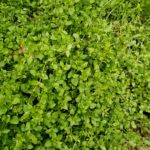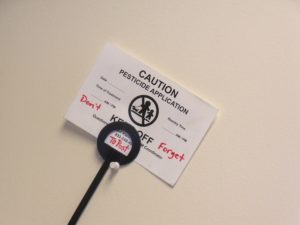Next to urban wildlife what readers wanted more information on is staying in compliance or understanding how some of the school IPM rules are interpreted by the Texas Department of Agriculture Structural Pest Control Service Division. So the next couple of issues will pertain to this topic.
Several of the top ten non-compliant problems for Texas schools boil down to paperwork. Top of the list is failing to have the Yellow Category Justification form. This failure comes from pesticide applicators not understanding what is considered Yellow category products.
Typically, Yellow category products are herbicides with a Caution signal word, insecticides that are broad spectrum or fungicides. Active ingredients like bifenthrin, cyfluthrin, deltamethrin, hydramethylnon, indoxacarb, fipronil, metaflumizone are all insecticides that can be used indoors and/or outdoors in baits, contact sprays and other methods. If the active ingredients are in a tamper resistant container than these active ingredients can be considered Green, but if they are applied via granules, spraying, or another broadcast method then they typically are considered Yellow and require a justification for use form. For more information on Green products check out this resource Recognizing Green Category Products
The Justification form is to be completed by the pesticide applicator, this includes anyone doing grounds applications as well as indoor applications or incidental use. The critical parts to this form are “description of pest problem” and “justification for use”. These statements are designed to inform the IPM coordinator and anyone else who asks, “why are you using this product”. Sometimes the true answer is it’s the only one that works, but that doesn’t cover the regulatory factor. To help illustrate the rule I am including a few examples from past experience for better understanding.
Example 1: There are multiple fire ant mounds that appeared after a spring or fall rain on an athletic field or playground. The IPM coordinator contacts the pesticide applicator and requests a treatment ASAP. The applicator responds that the product they can use is Advion* and they can be out tomorrow to make the treatment, but the fire ants won’t be eliminated for another 2 days. The coordinator agrees, then the applicator needs to complete the form. They will also need to post the
outdoor area at the time of application with a sign, or secured using a locking device, a fence or other practical barrier such as commercially available barrier caution tape, or periodically monitored to keep students out of the treated area until the allowed reentry time of 4 hours after application is completed. Remember the time for reentry starts once the application is completed. And remember they need to submit your application use record within two business days as well.
Description of pest problem: Heavy rains and varying temperatures have caused fire ant mounds to appear on elementary playground. Fire ants can sting children which can cause an adverse reaction.
Justification for use: Advion* is a fast-acting fire ant bait that can help reduce and control fire ants.
Example 2: There is a complaint about ‘roaches’ in several classrooms.  Your pest control contractor determined that both American and German cockroaches were present and chose to use Tempo Ultra WP*. Since this will be an indoor treatment remember no students can be present and a notice must be posted 48 hours in advance, and it’s up to the coordinator that this is done. The applicator needs to complete the justification form and present that with the service ticket. The coordinator needs to ensure no students can enter the treated area 4 hours after the application has occurred.
Your pest control contractor determined that both American and German cockroaches were present and chose to use Tempo Ultra WP*. Since this will be an indoor treatment remember no students can be present and a notice must be posted 48 hours in advance, and it’s up to the coordinator that this is done. The applicator needs to complete the justification form and present that with the service ticket. The coordinator needs to ensure no students can enter the treated area 4 hours after the application has occurred.
Description of pest problem: Wing of school campus has had water leaks, cardboard storage and other problems that have led to a heavy infestation of German and American Cockroaches.
Justification for use: Tempo Ultra WP* is a fast-acting insect control measure that will knock down the current population so that IPM measures can be implemented after this high presence of cockroaches is reduced.
Red Category justification forms are also in the top ten in noncompliance with TDA School IPM inspections. The following example is designed to help you understand documenting a Red category product.

Chickweed is a cool season weed that can appear in turf, ornamental beds, or other areas where it’s not wanted.
Example 3: Your school district has built or renovated a school campus and during construction the turf area was not maintained. It’s early March and the area is covered in henbit, chickweed, and dandelions. Your grounds manager comes to you and requests to use Trimec 992 Broadleaf Herbicide* so that he can “kill” everything so we can sod for turf this spring. This product has a Danger Signal word making it Red Category.
Description of pest problem: Broad-leaf weeds are covering a large turf area that needs to be eliminated prior to installing replacement turf.
Justification for use: Trimec 992* is a fast-acting herbicide that control a variety of broadleaf weeds. This product will also allow us to re-establish a turf area within three to four weeks.
As this is a Red category product you will also need to post the outdoor area at the time of application with a sign, or secured using a locking device, a fence or other practical barrier such as commercially available barrier caution tape, or periodically monitored to keep students out of the treated area until the allowed reentry time of 8 hours after application is completed. Remember the time for reentry starts once the application is completed, so you might want to do an application like this when you know you can restrict student use for a full day.
Another frequent item that schools make mistakes is who can be trained for incidental use and what types of pests can be treated under this heading. Incidental Use allows the IPM Coordinator the ability to train someone within the district, whose primary responsibility, is NOT to respond to pest complaints or calls, but to treat an occasional pest problem.
For this to happen, the pest problem must be considered an emergency like fire ants in a classroom, bees, wasps, or hornets next to an exit door, or some other stinging or venomous insect. The rule allows the coordinator to train an individual on a specific insecticide for use in a specific location or area. The coordinator must train the employee on the Incidental Fact Sheet English or Incidental use for fact sheet schools Spanish prior to any application.
Example 4: The district has an A/C tech that travels the district replacing filters and other A/C related repairs. When this individual gets to a site and it has a hornet’s nest in close proximity of
the A/C unit, this individual under Incidental Use could use their supplied can of hornet killer to help reduce the insect population. This same individual would need to complete a Pesticide Application Record for Incidental Use and return that form to the school IPM coordinator.
The Texas Department of Agriculture (TDA) also requires the IPM Coordinator to train this individual on incidental use fact sheet, basic information about the product they are using like proper usage, PPE, and other things they need to consider before and during use. If you or this person finds themselves constantly treating for pests, then TDA would want that person to become licensed. Incidental use means occasionally dealing with a pest problem, not a weekly remediation.
One of the questions I receive during our school IPM training is how you really handle incidental use. My answer is simple, train an individual you trust and document it. Give them a can of wasp killer along with 10 of the application use records they need to complete. When they have used the can up and you have received all their documentation, then you can issue another can and paperwork. If you have to make yourself a reminder in your calendar or hand-written note, just be sure to check in on that individual to make sure they haven’t used up the product but didn’t complete paperwork. It’s on you the coordinator to ensure that everyone is following the IPM program and if they are not, report that to your supervisor or superintendent.
Written by: Janet A. Hurley, ACE, MPA, Texas A&M AgriLife Extension, Extension Program Specialist III
(* The information given herein is for educational purposes only. Reference to commercial products or trade names is made with the understanding that no discrimination is intended and no endorsement by the AgriLife Extension Service is implied.)



 .
.